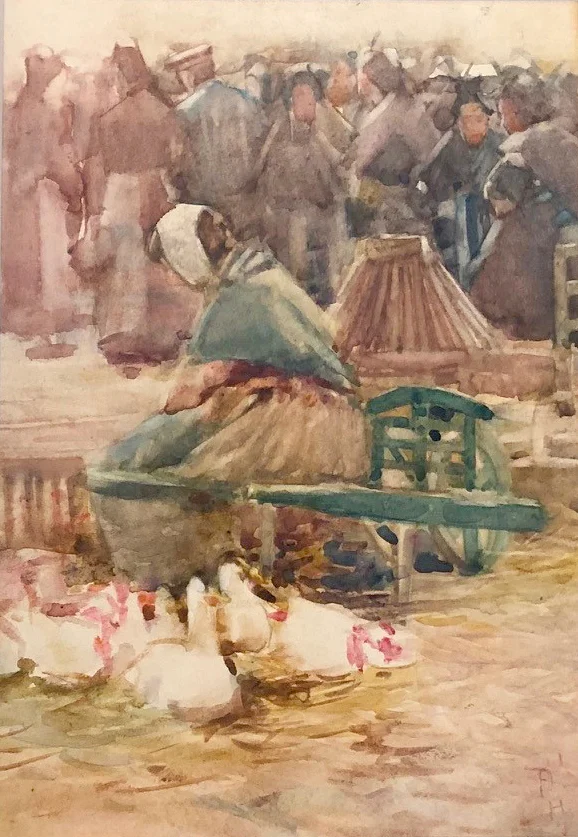-
Frances Hodgkins
The Poulterers’ Corner, Arles c.1901
Watercolour, 18 x 11.5 cm
Signed with monogram FH lower right
To Isabel Field from F.H., 6 November 1901, Hotel du Forum, Arles, S. Rhone
...this stall (the butcher's) is flanked by the poulterer on the left who is always in a cloud of feathers and distressed cackling and gurgling from the strangling victims.
Market scenes formed the staple element of Frances Hodgkins’ output on her first northern hemisphere trip that began in April 1901 and ended with her return to New Zealand in December 1903. In the small towns visited by the peripatetic artist during that exciting time, the market-place offered both the picturesque and the everyday, on which she built an appealing variant of the ‘peasant-painting’ trend popular since the 1880s in both England and France. The New Zealand audience was already primed by artists with whom she might have compared herself, such as Charles Worsley. At the annual regional exhibitions, the subject was purveyed in numerous Continental variations to spectators inclined towards a positive if sentimental view of rural and small-town life and ‘the old ways’ that urbanisation was at that point in time rudely undercutting.
Hodgkins visited the southern city of Arles on her very first foray into France, after the Irish painter Norman Garstin had introduced her and her travelling companion, the artist Dorothy Richmond, to Normandy and Paris. Travelling by train, they were seeking warmer weather as the northern summer turned to autumn. In about a month spent in Arles, Hodgkins produced a good deal of work that shows how rapidly she was maturing in her use of the medium, her compositional instincts, and her ability to capture character and expression. As the artist wrote home to her mother, “It is all ever so nice here, quite what I want and plenty of stuff to paint for months to come ... it is a land of enchantment you can’t help painting, everything and everybody is a picture”. Possible motifs abounded: she mentions vineyards, canals, washerwomen on the riverbank and Roman remains as well as the infinitely stimulating market.
While the location of Hodgkins’ market scenes is not always identified, those whose titles specify that they were made in this historic town suggest the range of motifs available there. They include La Place, Arles (Hocken Library, Dunedin), A busy Corner in Arles (Harris Museum and Art Gallery, Preston), Waiting for a Customer, Arles (whereabouts unknown) and The Vegetable Stall, Arles (unidentified).
By this time, Hodgkins had already amassed a number of market scenes, such as Breton Pottery, and she was to make many more over the next twelve months in San Remo, Italy and Dinan, Brittany. The present work was probably not meant for exhibition but, on this small scale, was more likely to have been a sketch made on the spot intended to serve as the model for a larger, more finished watercolour painted after the event. It is a close relation to the study made on the same scale called Geese and Ducks for Sale (McCormick no. 144), sold at auction in this country in November 1986. The principal difference is in the background, where the artist has substituted the wall of a building for the dense crowd seen here. There are likely to have been more in this suite of studies, the others yet to come to light.
_
Written by Pamela Gerrish Nunn
Exhibited
Auckland, N.Z. Jonathan Grant Gallery, Frances Hodgkins: A New Zealand Modernist, June 2019
Reference
Frances Hodgkins Database FH0339
(completefranceshodgkins.com)
Provenance
1954 Lady Elliott, Wellington Sir Lindo Ferguson, Auckland

